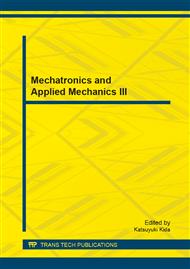p.332
p.337
p.342
p.346
p.351
p.356
p.362
p.367
p.374
Study on Tube Formation Mechanism and Lateral Stiffness Testing Method of the Tubular Conveyor Belt
Abstract:
The tubular conveyor belt is a main part of the conveyor belt industry. The lateral stiffness value is an important parameter measuring the performance of the tubular conveyor belt. Therefore, the lateral stiffness value is an important factor to test the quality of the tubular conveyor belt. Because of the complexity in measuring the tubular conveyor belt, at present, there is no unified method to measure the lateral stiffness of a tubular belt and no unified national standard for the stiffness value, which is the criterion that domestic enterprises lack to guide their production. The paper conducts the research on testing mechanism and testing methods of stiffness value, further demonstrates them by experiments, and solves the problem of poor reproducibility and large error of the stiffness value.
Info:
Periodical:
Pages:
351-355
Citation:
Online since:
February 2014
Authors:
Keywords:
Price:
Сopyright:
© 2014 Trans Tech Publications Ltd. All Rights Reserved
Share:
Citation:


